What is Projectile Motion | Physics for EmSAT Achieve PDF Download
| Table of contents |

|
| What Is Projectile? |

|
| What Is Projectile Motion? |

|
| Total Time of Flight |

|
| Basketball Physics |

|
| Solved Examples |

|
What Is Projectile?
A projectile is any object thrown into space upon which the only acting force is gravity. The primary force acting on a projectile is gravity. This doesn’t necessarily mean that other forces do not act on it, just that their effect is minimal compared to gravity. The path followed by a projectile is known as a trajectory. A baseball batted or thrown is an example of a projectile.What Is Projectile Motion?
When a particle is thrown obliquely near the earth’s surface, it moves along a curved path under constant acceleration directed towards the centre of the earth (we assume that the particle remains close to the earth’s surface). The path of such a particle is called a projectile, and the motion is called projectile motion.In a Projectile Motion, there are two simultaneous independent rectilinear motions:
- Along the x-axis: uniform velocity, responsible for the horizontal (forward) motion of the particle.
- Along the y-axis: uniform acceleration, responsible for the vertical (downwards) motion of the particle.
Acceleration in the horizontal projectile motion and vertical projectile motion of a particle: When a particle is projected in the air with some speed, the only force acting on it during its time in the air is the acceleration due to gravity (g). This acceleration acts vertically downward. There is no acceleration in the horizontal direction, which means that the velocity of the particle in the horizontal direction remains constant.
Parabolic Motion of Projectiles
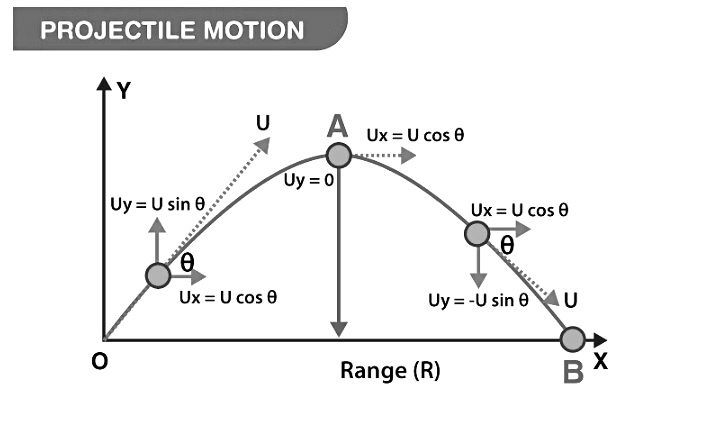
The point O is called the point of projection; θ is the angle of projection and OB = Horizontal Range or Simply Range. The total time taken by the particle from reaching O to B is called the time of flight.
For finding different parameters related to projectile motion, we can make use of differential equations of motions:
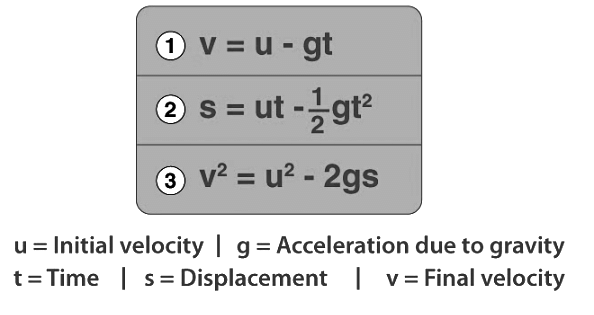
Total Time of Flight
Resultant displacement (s) = 0 in Vertical direction. Therefore, the time of flight formula is given by using the Equation of motion:gt2 = 2(uyt – sy) [Here, uy = u sin θ and sy = 0]
i.e. gt2 = 2t × u sin θ
Therefore, the time of flight formula (t) is given by:

Horizontal Range
Horizontal Range (OA) = Horizontal component of velocity (ux) × Total Flight Time (t)R = u cos θ × 2u×sinθg
Therefore, in a projectile motion, the Horizontal Range is given by (R):

Maximum Height of Projectile
After understanding what a projectile is, let us know the maximum height of the projectile. The object’s maximum height is the highest vertical position along its trajectory. The horizontal displacement of the projectile is called the range of the projectile. The range of the projectile depends on the object’s initial velocity.
If v is the initial velocity, g = acceleration due to gravity and H = maximum height in metres, θ = angle of the initial velocity from the horizontal plane (radians or degrees).
The maximum height of the projectile is given by the formula:

The Equation of Trajectory

This is the equation of trajectory in projectile motion, and it proves that the projectile motion is always parabolic in nature.
Basketball Physics
We know that projectile motion is a type of two-dimensional motion or motion in a plane. It is assumed that the only force acting on a projectile (the object experiencing projectile motion) is the force due to gravity. But how can we define projectile motion in the real world? How are the concepts of projectile motion applicable to daily life? Let us see some real-life examples of projectile motion in two dimensions.
All of us know about basketball. The player jumps a little to score a basket and throws the ball in the basket. The motion of the ball is in the form of a projectile. Hence, it is referred to as projectile motion. What advantage does jumping give to their chances of scoring a basket? Now, apart from basketballs, if we throw a cricket ball, a stone in a river, a javelin throw, an angry bird, a football or a bullet, all these motions have one thing in common. They all show a projectile motion. And that is, the moment they are released, there is only one force acting on them- gravity. It pulls them downwards, thus giving all of them an equal, impartial acceleration.
It implies that if something is being thrown in the air, it can easily be predicted how long the projectile will be in the air and at what distance it will hit the ground from the initial point. If the air resistance is neglected, there would be no acceleration in the horizontal direction. This implies that as long as a body is thrown near the surface, the body’s motion can be considered a two-dimensional motion, with acceleration only in one direction. But how can it be concluded that a body thrown in the air follows a two-dimensional path? To understand this, let us assume a ball that is rolling as shown below:
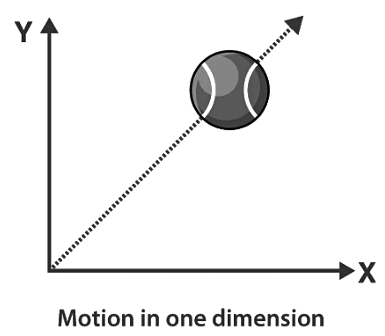
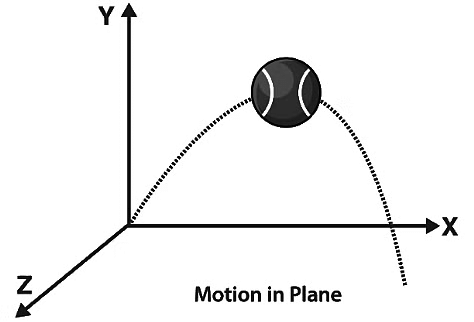
Figure 2 Motion in PlaneNow, if the ball is thrown at some angle, as shown, the velocity of the ball has an x-component and a y-component and also a z-component. So, does it mean that it is a three-dimensional motion? It can be seen here that a line cannot define such a motion, but a plane can. Therefore, for a body thrown at any angle, there exists a plane that entirely contains the motion of that body. Thus, it can be concluded that as long as a body is near the surface of the Earth and the air resistance can be neglected, then irrespective of the angle of projection, it will be a two-dimensional motion, no matter how the axes are chosen. If the axes here are rotated in such a way that, then and can completely define the motion of the ball as shown below:
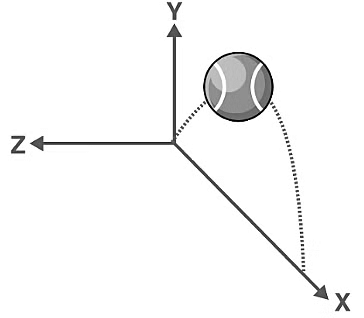
Thus, it can be concluded that the minimum number of coordinates required to define the motion of a body completely determines the dimension of its motion.
Solved Examples
Q1. What is the maximum height reached by the object?
Q2. What is the object’s total flight time (between launch and touching the ground)?
Q3. What is the object’s horizontal range (maximum x above ground)?
Solution:
The velocity components Vx and Vy are given by the formula:

In the given problem,
The component y gives the height of the projectile, and it reaches its maximum value when the component Vy is equal to zero. That is when the projectile changes from moving upward to moving downward.
Substituting and solving for t, we get

To find the maximum height, substitute t in the equation y, and we get

Solving, we get

The maximum height reached by the object is 47.9 metres.
The time of flight is the interval between when the projectile is launched (t1) and when the projectile touches the ground (t2).
Hence,

Solve for t

Solving, we get two solutions as follows:

Time of flight can be calculated as follows:

Horizontal Range is the horizontal distance given by x at t = t2.
= 6.25 meters
|
212 videos|286 docs|193 tests
|
FAQs on What is Projectile Motion - Physics for EmSAT Achieve
| 1. What is projectile motion? |  |
| 2. What factors affect projectile motion? |  |
| 3. How is the total time of flight calculated in projectile motion? |  |
| 4. What are some examples of projectile motion in real life? |  |
| 5. How does basketball physics relate to projectile motion? |  |














